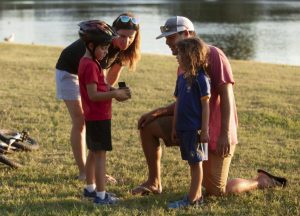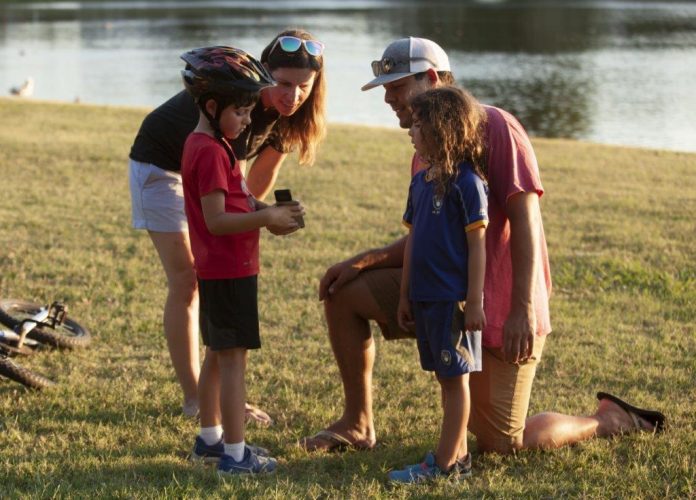
By Sarah Villarreal
It was around 7:45 p.m. last October when we really began picking up the bats on the Echo Meter.
First the Evening bat, next Tri-Colored and Northern Yellow bats. Within the next 20 minutes my device detected a total of seven different bat species flying over Rheudasil Pond in Flower Mound.
It’s a sight which often goes unseen, but with a smartphone detector in hand we were able to hear some actual vocalizations as the bats flew closer to the water. I knew this would be our best shot at ‘seeing’ bats as they head for a drink of water upon emerging from their roosting sites each evening.
The fact is, ‘observing’ bats can be an educational and kid-friendly way to get your family into nature, along with building children’s comfort with the great outdoors.
Immersing ourselves and our families into nature can lead us through a variety of emotions, especially when we have young children. We may find ourselves weighing our decision with worrying about the potential cleanup of ‘nature’s mess’ on our shoes and clothing.
However, would it help tip the scales if you knew that exposure to the environment has profound health benefits? Benefits such as increased physical activity, improved mental health, and increased relaxation, just to name a few.
If you’re anything like me and trying to find ways for your kids to expend energy, taking them outside has the added bonus of promoting positive social behavior. If you include other family members and friends, this amplifies the impact emotionally.
In a nation where students are tested on their memorization and specific curriculum aligning with standardized testing, nature provides a platform for inquiry and investigation. Getting outside is important and joining me for a bat walk this year is a fun, and exciting way to do this.
What is a bat walk? Bat Conservation International (BCI), created this volunteer program in early 2019 training interpreters throughout the state of Texas on how to teach people about bats. Having completed this training allows me the opportunity to share my knowledge of bats while also identifying local species through the use of a smartphone-compatible bat detector.
Bats are mammals that are ever-present across Texas and Denton County. When you read the word ‘bat’, what came to mind? Myths such as how these blind rodents will dive into women’s hair and get tangled? Perhaps you think of vampire bats wanting to suck your blood, or how bats carry rabies and spread this to humans and other animals?
Just to ease your mind on the above myths, they are not rodents, they are not blind, and you have nothing more to offer a bat than the perception of a threat.
While bats can carry rabies, this disease often makes the bat extremely ill, so unless you’re messing with a grounded bat (please don’t, there are specialists for that), no bat is going to go out of its way to harm you.
With more than 1400+ species of bats around the world, only three are vampire bats, and only one of these feeds on the blood of mammals. More importantly, none of these three species inhabit North America.
In Texas we have 32 bat species represented in our state. Holding true to the traditional Texan phrase, “Everything’s bigger in Texas,” Mexican Free-Tailed bats (also known as Brazilian free-tails) living south of us at Bracken Cave near San Antonio account for the largest group of mammals found anywhere in the world.
Each evening around sundown, as many as 20 million bats fly out of Bracken Cave to forage. This species primarily feeds on insects, consuming upwards of 147 tons of bugs each night. As the fastest flyer in the world, they dive and swoop at an average speed of 98 mph and will go as high as 10,000 feet.
Bats in general readily consume agricultural pests while also being important pollinators for many types of plants including the agave. Without bats, there would be no agave. Without agave, there would be no tequila.
Bats are everywhere, and provide services essential to our economy, saving farmers $23 billion annually in pesticides and crop damage. In Austin alone they contribute 14 million dollars in tourism revenue just because people like to watch them fly in and out from the Congress Street Bridge each night.
What’s amazing is within our community, I am finding we are species-rich with bats. As a resident of Flower Mound, I can honestly say that I greatly appreciate bats and welcome them into my neighborhood.
I am a mother who loves being outdoors, and I have concerns about the disappearance of wildlife as our community continues to expand. If you’d like to learn a bit more about these amazing mammals, I’m here to offer you a fun, creative way to do so this summer. If you’re interested in getting out with family and friends (following recommendations of social distancing) join me on a bat walk now through November.
Each bat walk lasts 45 minutes to one hour, beginning with 25 minutes of learning fun facts on bats around the world and how we can aid with their conservation locally.
For example, did you know that arousing a bat from hibernation costs it three months of energy; or that bats can learn new sounds? This informal discussion is then followed by identifying bat species we locate with our bat detector, and maybe even hear with our own ears. Together we can dispel common myths, disgusts, or fears (especially in your young ones) through a positive and informational experience. In addition to experiencing benefits for our health, we’ll keep on the trail so as to avoid any messes from the great outdoors.
If learning about and looking for bats interests you and your family, please contact me via email at villars@miamioh.edu and I will be happy to coordinate small groups throughout the summer. Walks typically take place at Rheudasil Park in Flower Mound though I am happy to check out additional places throughout our community as well. Start times depend on sunset and all ages are welcome.
Sarah Villarreal works at the Dallas Zoo, is a resident of Flower Mound, and completed this project as a part of her graduate work with Project Dragonfly at Miami University in Oxford, Ohio. Special thanks to Erin Cord, Bat Walk Network Coordinator for BCI.
Visit www.batcon.org for more information.





















